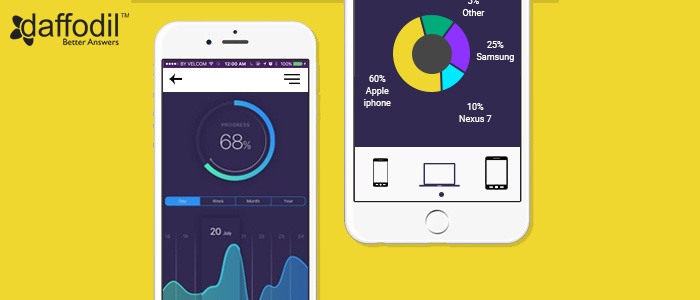
Mobile apps are a part of our micro-moments. From latest news to fitness logging to finding way to meeting, we reach out an app for almost everything. That is why, businesses ascertain that they include mobile app into their technology roadmap.
Today, more than app development and deployment, what has become more challenging for businesses is to engage the users and retain them, even after a great count of number of app downloads.
In the attempts to resolve the app performance, user engagement and retention issues, mobile app analytics is considered as the true rescue system. While app analytics tools are robust and offer insightful details about the app-user association, they too turn out to be a problem for app developers and stakeholders for a variety of reasons.
Key Challenges
- Tools for mobile app analytics are offered by a number of vendors, with multifarious capabilities. This makes it difficult for the app development team to draw distinction between the available options and choose a tool to collect relevant metrics.
- Smartphones produce a lot of data - location information, demographics, app usage time, online behaviour, address book, and even more. This insufficient, in-depth analysis of mobile app metrics takes away the attention from what matters the most.
- The data and information collected from mobile analytics tool is enormous. This as a consequence makes it difficult for enterprises pick out meaning metrics and then optimize them in the iterative phase of development.
Mobile app development team, along with the stakeholders should communicate about metrics that are relevant to the business and maximize engagement, performance, and ultimately, return on investment. App analytics metrics are a significant part of mobile app development and update cycle as hints the business about ways to increase user retention, identify features that users might find helpful, enhance overall user experience etc. Here is how.
1. Performance Analytics for Mobile Apps
In the performance analytics of an app, essential details on its technical behaviour is collected, which are then correlated to the device hardware configurations and network conditions.
Analyzing performance metrics is essential to catch and fix the unusual behaviour of the app that leads to user vexation, app abandonment, and eventually low retention rate. That is why, analyzing performance metrics at both testing phase and after its release to the marketplace is significant.
During the development and testing stage of a mobile app, the QA team analyzes the app for bugs and incompatibilities. This process can either be manual or automated through scripts. However, it is not possible to analyze all the issues in pre-production testing.
In the post-deployment scenarios, mobile app analytics tools like AppSee, HockeyApp etc. can be used. These apps are embedded to the mobile apps, which then collects, correlates, and analyze the performance metrics in real time.
When collecting the performance metrics, make it a point that they correlate with the following data points:
- Device Details: This may include the device type and model, Operating System and version, hardware configuration .
- App Operations: Analyze resource consumption when an activity is performed (memory, storage space), touch gestures on a screen, session length etc.
- WiFi Conditions: App performance in low signal strength, carrier and location information etc.
In addition to these third party tools, there are add-ons offered by some mobile app development platform like Xamarin, Kony that enables logging all performance metrics. These app analytics tools ensure that any bugs or performance issues are informed on time and improvements are made to release the better version of the app.
ALSO READ: Top 10 Mobile App Analytics Tools to Build Ultra-Performing Mobile Apps
2. Behavioural Analysis of Mobile Apps
No matter how technically strong an app is, it will never lead to user engagement or retention unless if offers seamless usability. Improvements in UX is possible when user’s behaviour with the app is inspected.
Compared to performance metrics, exploring the behavioural data of users is a bit complex and challenging. Reason being, a number of businesses are still not clear about the behaviours where they should focus their attention to.
In most of the cases, the behavioural metrics analyzed are not even translated into improvements. For example: If you are inspecting the feel-good statistics like registered users, session duration, screen views etc., they won’t add an advantage to the app updation process.
To determine the key performance indicators, the idea is to discuss the business goals with the stakeholders and then enlist the true metrics that matter. When it's about behavioural analytics that derive app improvements and also contribute to the business outcomes, then these metrics shared below must be checked out.
- Usage Heat Maps: Tap, swipe, pinch. Every gesture on the screen counts and offers an insightful information about the page or segment of an app that matters the most to the users. Along with this, heat maps can also help in UI/UX improvements. Say, the heat map report users to be continuously tapping on an image (having look and feel of a button). Continuous tapping of users on an image is an indicator that the app’s UI is misconceptualized by the users.
- Retention Analysis: How often does the user return to an app? By estimating a user’s tendency to come back to an app and utilize its functionality says a lot about its retention. By analyzing the time period between app’s installation and then the number of times it is used in a day, week, or month describe the retention rate of an app.
- App Funnel Analysis: Every app has got a series of goals. For example: An eCommerce app has to respond to search queries, display results according to filters applied, process payments with staging, track product delivery, and a lot more. How is the app performing all of these actions elaborates the user engagement rate with it.
Similar to performance analytics, there are third party tools available for in-depth behavioural analysis of an app. Some of the popular names in the list includes Mixpanel, Countly, Localytics etc. Also, there are mobile app development platforms that offer insightful Appcelerator, IBM MobileFirst that can enable collecting behavioural pattern of users with the app.
ALSO READ: Mobile App KPIs to Measure App Performance and Engagement
Deploying Mobile App Analytics Tools Relevant to their Use Cases
Mobile app analytics tools that enable locking operational and behavioural data of an app are the drivers of improvement. With plethora of options available to analyze key metrics, the app development team can collaborate with the business stakeholders to understand the goals of the app, use cases, targeted users and embed the tool accordingly.
Analyzing N number of metrics, without realizing their contribution in refining the app is waste of resources, money, and time. At Daffodil, our mobile app development services include thorough examination of all the necessary metrics, before starting to analyze them to meet business goals. When sourcing your app development project, make it a point to discuss about the pre and post metrics analysis for successful app deployment and iteration.



